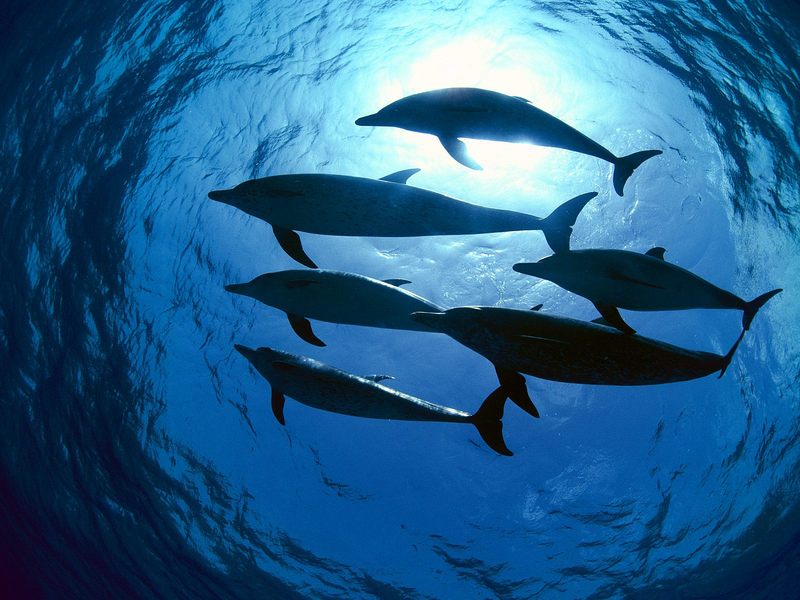|
| Query: bottlenosed dolphin | Result: 96th of 165 | |
Atlantic Spotted Dolphin (Stenella frontalis) - Wiki
| Subject: | Atlantic Spotted Dolphin (Stenella frontalis) - Wiki
| |

| Resolution: 1600x1200
File Size: 357621 Bytes
Upload Date: 2007:09:24 04:09:19
|
Atlantic Spotted Dolphin
From Wikipedia, the free encyclopedia
[Photo] Atlantic Spotted Dolphins, Stenella frontalis, Bahamas. Date August 16, 2007. Author Niranjan (http://www.flickr.com/people/9075901@N02)
The Atlantic Spotted Dolphin (Stenella frontalis) is a dolphin found in the Gulf Stream of the North Atlantic Ocean. Older members of the species have a very distinctive spotted coloration all over their body.
Taxonomy
The Atlantic Spotted Dolphin was first identified by Cuvier in 1828. There is considerable variation in the physical form of individuals in the species and specialists have long been uncertain as to the correct taxonomic classification. Currently just one species is recognised, however it is quite possible that a large, particularly spotty variant commonly found near Florida may be classified as a formal subspecies or indeed a species in its own right.
Physical description
The coloring of the Atlantic Spotted Dolphin varies enormously as they grow. Calves are a fairly uniform grey colour. When the calves are weaned, they then begin to get their spots. Juveniles have some dark spots on their belly, and white spots of their flanks. Their back and dorsal fin are a darker grey than the rest of the body. As the animal matures the spots became denser and spread all over the body until at full physical maturation the body appears black with white spots.
The Atlantic Spotted Dolphin has a 3-part coloration:
Dark gray back, lighter sides, and a white belly.
Measurments at Birth:
Length: about 35"-43" (90-110 cm)
Weight: unavailable
Maximun Measurments:
Length:
Male 7'5" (2.26 m)
Female 7'6" (2.29 m)
Weight:
Male 310 lb. (140 kg)
Female 290 lb. (130 kg)
These dolphins are a middle sized dolphin in both legth and weight. At full size South American Spotted Dolphins are about 2.2-2.5m in length. Compared to their much smaller pantropical spotted dolphin, the atlantic spotted dolphin is more robust. It lives in common waters with the pantropical spotted dolphin and the bottlenose dolphin.
In common with other species in its genus the Atlantic Spotted is a gregarious creature. It is a fast swimmer, keen bow-rider and prone to acrobatic aerial displays.
Population and distribution
The species is endemic to the temperate and tropical areas of the Atlantic Ocean. It has been widely observed in the western end of the Gulf Stream, between Florida and Bermuda. It is also present in the Gulf of Mexico. More infrequent sightings have been made further east, off the Azores and Canary Islands. Northerly sightings have been made as far north as Cape Cod across to the south-western tip of Spain. They are certainly present further south too as far as Rio Grande do Sul in Brazil and across to west Africa. However the distribution is poorly understood in these areas.
About 20 years ago, there where only about 80 dolphins in the Bahamas. Now, 20 years later, there are almost 200 dolphins there. On account of their similar appearance to other dolphins in their range it is difficult to be sure of the Atlantic Spotted Dolphin's population. A conservative estimate is around 100,000 individuals.
Human interaction
Some Atlantic Spotted Dolphins, particularly some of those are around The Bahamas have become habituated to human contact. In these areas cruises to watch and even swim with the dolphins are common.
Atlantic Spotted Dolphins are an occasional target of harpoon fishermen and every year some creatures are trapped and killed in gillnets. However these activities are not currently believed to be threatening the survival of the species.
http://en.wikipedia.org/wiki/Atlantic_Spotted_Dolphin
| The text in this page is based on the copyrighted Wikipedia article shown in above URL. It is used under the GNU Free Documentation License. You may redistribute it, verbatim or modified, providing that you comply with the terms of the GFDL. |
|
Comments |
|---|
| | Guest |
|
| it is very cool how much people know about dolphins today and that reason is because of our modern technology thx [thanks]to who ever invented such a smart thing |
| | Guest |
|
Scientific Name: Stenella frontalis (G. Cuvier, 1829)
Common Names:
English – Atlantic Spotted Dolphin, Bridled Dolphin
French – Dauphin Tacheté De L'Atlantique
Spanish – Delfín Manchado Del Atlántico, Delfín Pintado
Synonyms: Stenella plagiodon Cope, 1866 |

|

|

|
bottlenosed dolphin
96/165 |

|

|
^o^
Animal Pictures Archive for smart phones
^o^
|
|
|